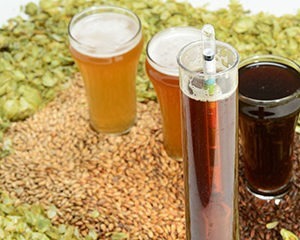Make the Most of Your Hop Back
As a brewer it is always exciting to find out that a process you are already practicing can be expanded and voilá, better beer. Such is the case with a hop back.
A hop back (also known as a hop jack) in its simplest form is nothing more than a strainer, originally intended to remove the whole hops from the wort before cooling. It could be in the form of a false bottom consisting of a screen or perforated plate built into the kettle, or an external device through which the wort is run.
In either case the screen or plate catches the whole hop cones, which then act as a filter bed to catch more hops and the trub from the boil. You can see where the name comes from; the idea was to hold the hops back. At some point along the way, brewers discovered that adding a charge of fresh hops to the hop back gave the beer a distinct hoppy character. One theory is that this was discovered by accident; the brewer was probably just trying to make sure there were enough hops on the screen to form a filter bed before the wort was run through.
The hoppy flavor or character imparted by the hop back is quite different from either late kettle additions or dry hopping. The wort is no longer boiling, and the typical hop back is a somewhat closed system, so fewer of the volatile oils (responsible for the hops’ aroma and flavor) are lost. This is also the case with dry hopping, but the heat of the wort in the hop back causes many chemical changes to the oils that affect their flavor and aroma. These changes do not occur during dry hopping.
If you want to make a hop back at home, you have many options. If you are using whole hops and are currently using a strainer, the simplest method is to add some fresh whole hops to the strainer and run the wort through. You may have to upgrade the size of your strainer to handle the extra hops. Don’t forget to run the wort through prior to chilling.
If your kettle has a false bottom, simply toss the extra hops in the kettle after the boil, cover, and start your runoff. You can also use any “strainer equivalent” such as your lauter tun.
The more closed you can keep the system the more volatile oils you will retain. If you have a spigot on your kettle, you can build a totally enclosed hop back from a commercial water-filter housing.
First you’ll have to find one made of polypropylene to handle the high temperatures of the wort. It may take a bit of searching, but they do exist. Next you’ll have to replace the standard filter element with a tube made of stainless steel screen with mesh the size of a strainer or window screen. Cut the screen to the same length and inner diameter of the paper filter so it fits snugly between the top and bottom of the filter housing. If you can find a filter element with a perforated polypropylene core with holes of a proper size, you can try removing the filter material, leaving just the inner core, and then use that in place of the screen.
A little ingenuity will go a long way here. Adapt the input and output connections on the filter housing to fit your system’s tubing. Now just fill the housing (outside the screen) with fresh whole hops and run the wort through on the way to your chiller. You may want to “pre-filter” the wort as you normally do now to keep the hop back from clogging or reducing flow too much.
All of these solutions are fine if you are using whole hops. But what if you want to use pellets? Luckily there is a simple solution that will give you the same effect as a hop back. Simply toss an extra charge of pellets into the kettle after you turn off the heat and before you chill the wort. Cover the kettle, and let the hops steep for 20 to 30 minutes. It’s amazingly easy, and the effect will be indistinguishable from using a hop back.
How much hops should be used? That depends on the hop variety and its oil content. Because some hops have a more pronounced aroma than others, the variety makes a difference. Hops with a subtle aroma have less effect.
Keep in mind that hops used in a hop back or steeped after the boil (assuming it’s a gentle steep and you’re not whirlpooling or otherwise agitating the wort while it’s hot) will not contribute any significant amount of bitterness to the beer.
The oil content plays a role as well. Hops with a high oil content contribute more than hops with a lower oil content. A very common hop to use is Cascade. Taking Cascade as our baseline, start with about 1.5 ounces and see how you like it. You can adjust the quantity up or down depending on the variety, oil content, beer style, and your personal preferences.
A hop back allows you to experiment with different types and quantities of hops while it serves a practical purpose. And bragging about the great results from your hop back seems a lot more exciting than straining your wort.


